Abstract
A method of local cerebral hypothermia with circulatory arrest of one or more of the major vessels of the neck is described. Ten clinical cases have been operated upon, and much has been learned of the operative difficulties including an increased operating time and a high complication rate. There were four post-operative deaths, in one (case 1) there was some evidence that the technique protected the perfused part of the brain from anoxic damage. In case 9 the method itself caused particularly bad operating conditions and eventually the patient died. Case 2 and case 4, like case 1, were patients who were severely ill and who might well have died whatever technique had been used in operating upon them. Of the survivors, one patient (case 3) had a post-operative intracerebral clot which developed during closure and another (case 6) had an intracerebral clot which required removal after 24 hours. Another patient (case 8) had some delay in return to full mental function. In the light of this experience we cannot regard the method in its present form as satisfactory for general use. In our view, its further development requires the discovery of a more effective means of neutralizing the anticoagulants, or doing without anticoagulants altogether. It is also necessary to develop a method of monitoring parts of the brain distant from those directly perfused to give warning of threatened anoxia. Until such time as these problems can be solved we have returned to other procedures but are publishing our results in the hope that other workers will be able to improve upon them.
Full text
PDF


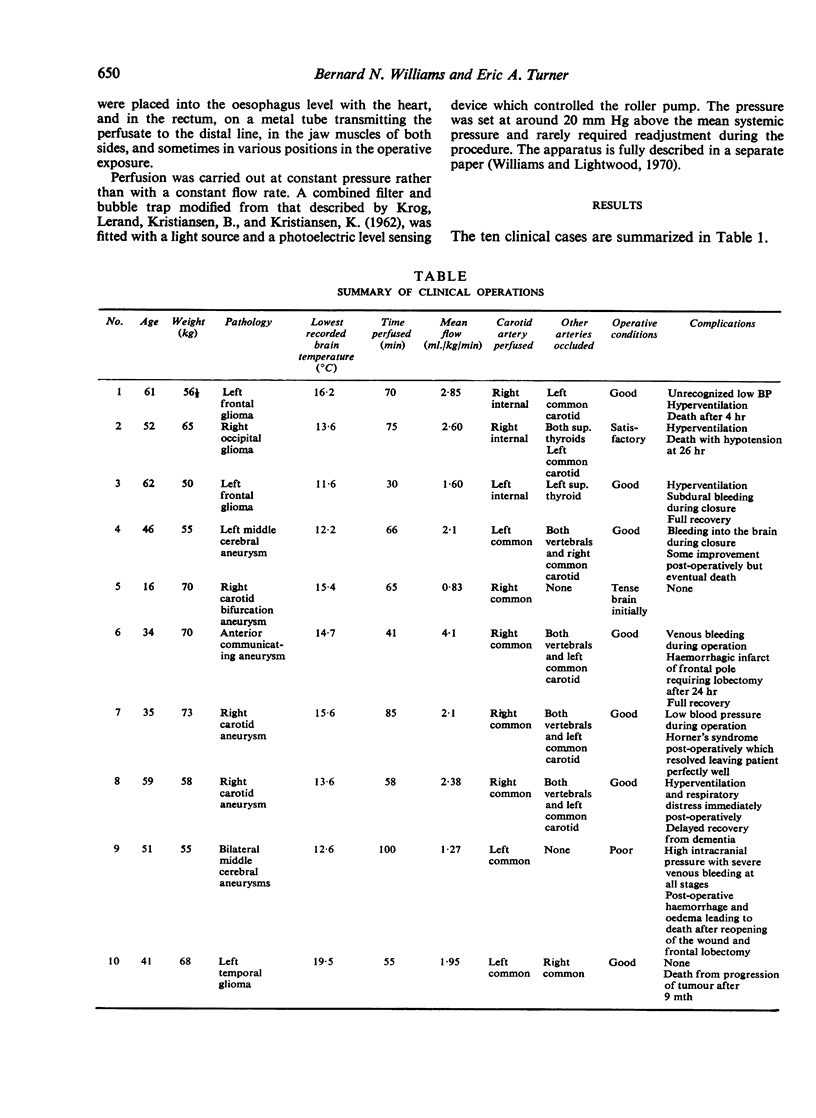
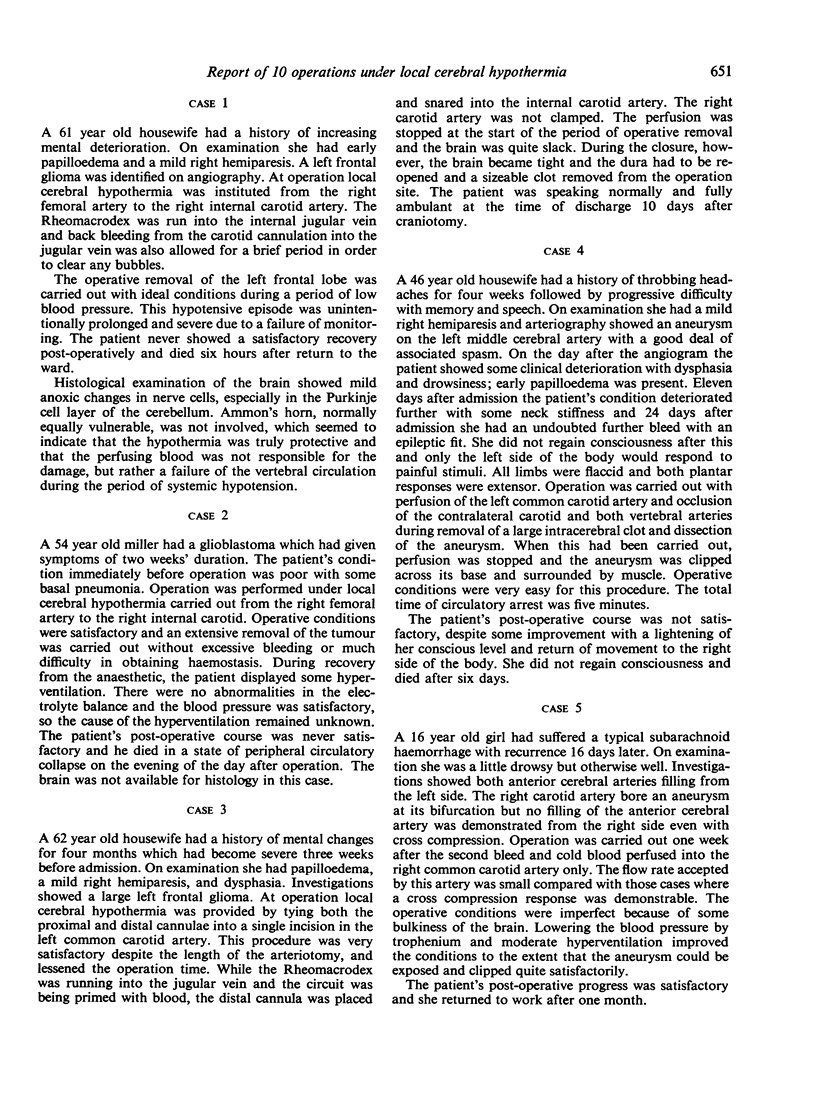
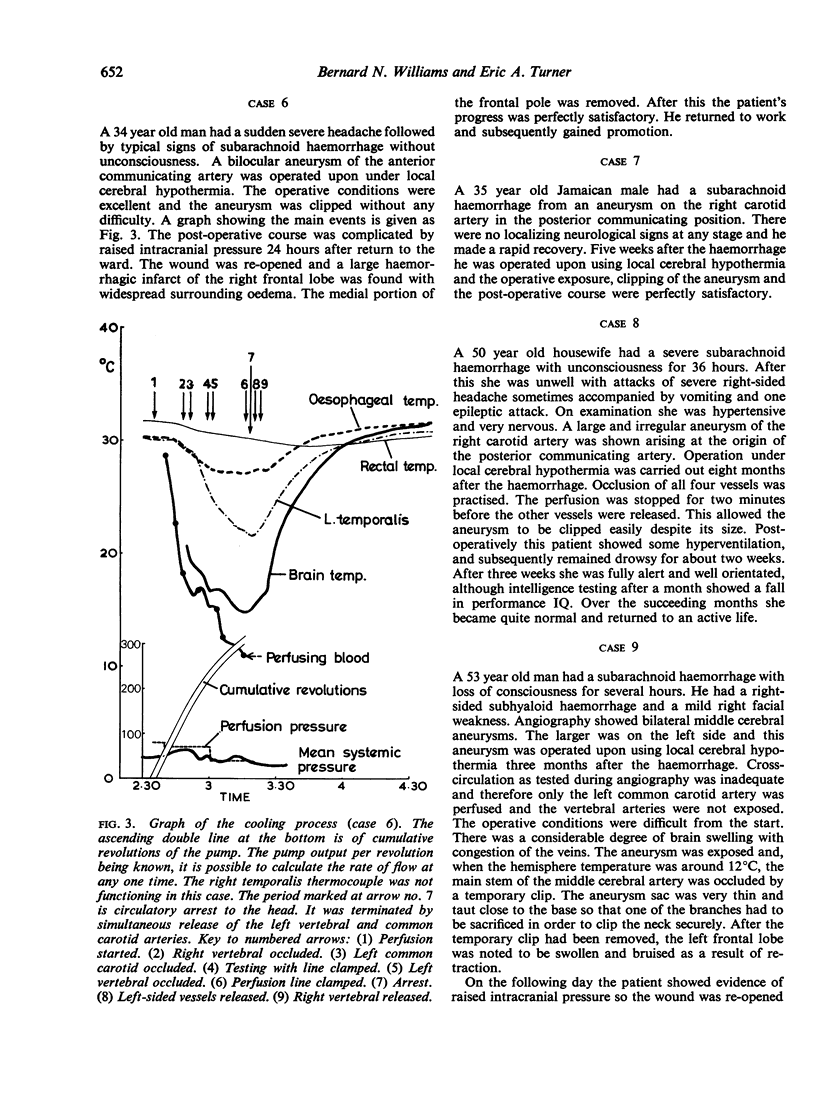
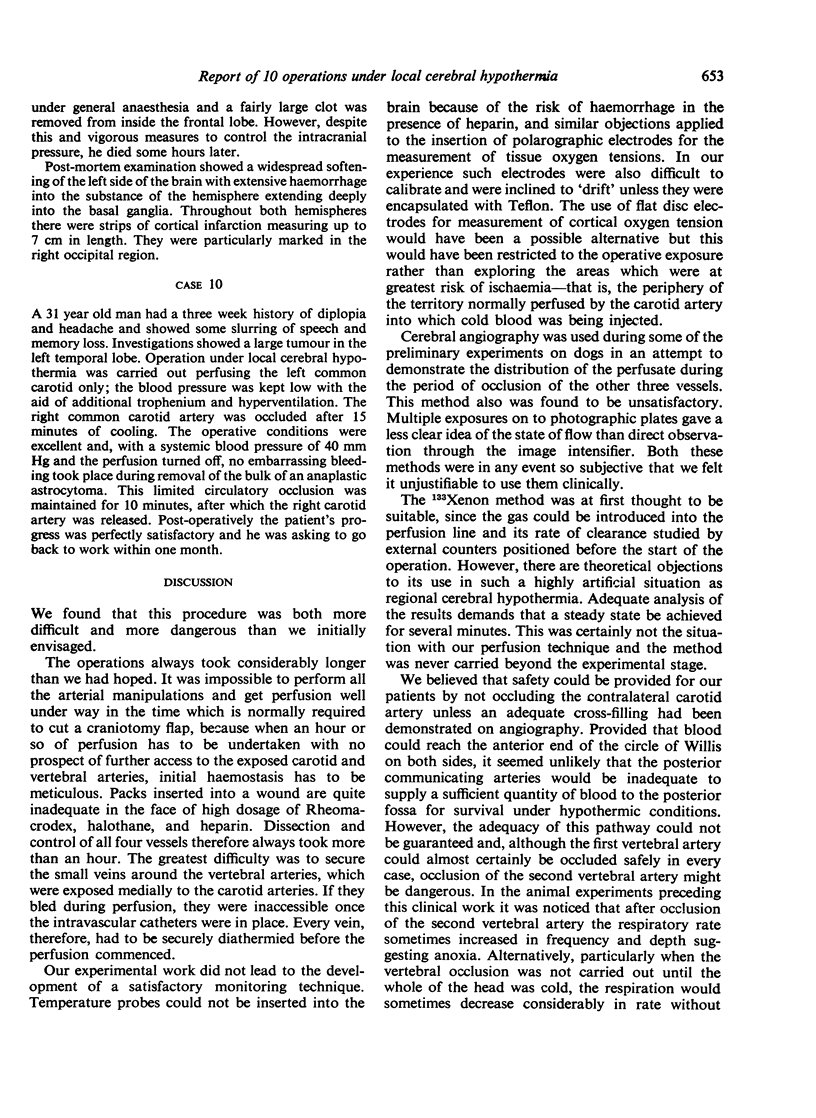

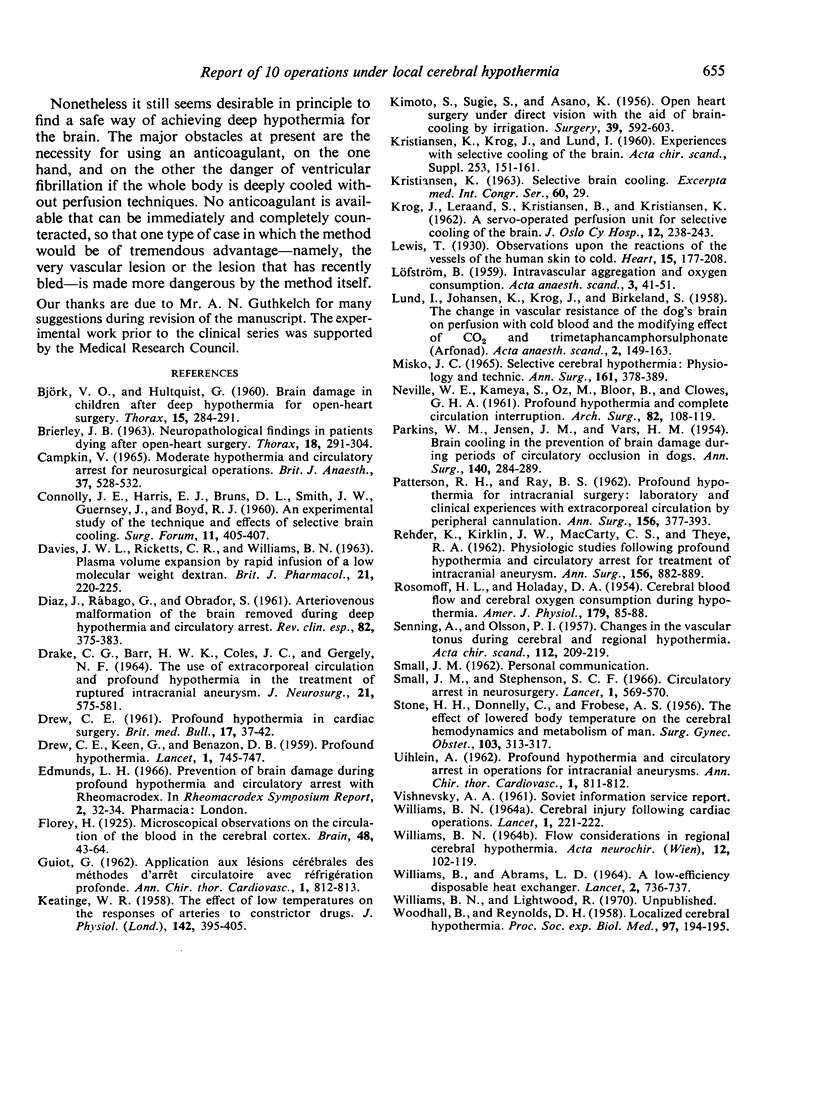
Selected References
These references are in PubMed. This may not be the complete list of references from this article.
- BRIERLEY J. B. NEUROPATHOLOGICAL FINDINGS IN PATIENTS DYING AFTER OPEN-HEART SURGERY. Thorax. 1963 Dec;18:291–304. doi: 10.1136/thx.18.4.291. [DOI] [PMC free article] [PubMed] [Google Scholar]
- CONNOLLY J. E., HARRIS E. J., BRUNS D. L., SMITH J. W., GUERNSEY J., BOYD R. J. An experimental study of the technique and effects of selective brain cooling. Surg Forum. 1960;11:405–407. [PubMed] [Google Scholar]
- Campkin V. Moderate hypothermia and circulatory arrest for neurosurgical operations. Br J Anaesth. 1965 Jul;37(7):528–532. doi: 10.1093/bja/37.7.528. [DOI] [PubMed] [Google Scholar]
- DAVIES J. W., RICKETTS C. R., WILLIAMS B. N. PLASMA VOLUME EXPANSION BY RAPID INFUSION OF A LOW MOLECULAR WEIGHT DEXTRAN. Br J Pharmacol Chemother. 1963 Oct;21:220–225. doi: 10.1111/j.1476-5381.1963.tb01519.x. [DOI] [PMC free article] [PubMed] [Google Scholar]
- DONNELLY C., FROBESE A. S., STONE H. H. The effect of lowered body temperature on the cerebral hemodynamics and metabolism of man. Surg Gynecol Obstet. 1956 Sep;103(3):313–317. [PubMed] [Google Scholar]
- DRAKE C. G., BARR H. W., COLES J. C., GERGELY N. F. THE USE OF EXTRACORPOREAL CIRCULATION AND PROFOUND HYPOTHERMIA IN THE TREATMENT OF RUPTURED INTRACRANIAL ANEURYSM. J Neurosurg. 1964 Jul;21:575–581. doi: 10.3171/jns.1964.21.7.0575. [DOI] [PubMed] [Google Scholar]
- DREW C. E., KEEN G., BENAZON D. B. Profound hypothermia. Lancet. 1959 Apr 11;1(7076):745–747. doi: 10.1016/s0140-6736(59)91824-0. [DOI] [PubMed] [Google Scholar]
- DREW C. E. Profound hypothermia in cardiac surgery. Br Med Bull. 1961 Jan;17:37–42. doi: 10.1093/oxfordjournals.bmb.a069861. [DOI] [PubMed] [Google Scholar]
- GUIOT G. [Application to cerebral lesions of methods of circulatory arrest with deep refrigeration]. Ann Chir Thorac Cardiovasc. 1962 May;1:812–813. [PubMed] [Google Scholar]
- JIMENEZ DIAZ C., RABAGO G., OBRADOR S. [Arteriovenous malformation of the brain removed during deep hypothermia and circulatory arrest]. Rev Clin Esp. 1961 Sep 30;82:375–383. [PubMed] [Google Scholar]
- KEATINGE W. R. The effect of low temperatures on the responses of arteries to constrictor drugs. J Physiol. 1958 Aug 6;142(3):395–405. doi: 10.1113/jphysiol.1958.sp006025. [DOI] [PMC free article] [PubMed] [Google Scholar]
- KIMOTO S., SUGIE S., ASANO K. Open heart surgery under direct vision with the aid of brain-cooling by irrigation; experimental studies and report of clinical cases, including three successfully treated cases of atrial septal defect. Surgery. 1956 Apr;39(4):592–603. [PubMed] [Google Scholar]
- KRISTIANSEN K., KROG J., LUND I. Experiences with selective cooling of the brain. Acta Chir Scand Suppl. 1960;Suppl 253:151–161. [PubMed] [Google Scholar]
- KROG J., LERAAND S., KRISTIANSEN B., KRISTIANSEN K. A servo-operated perfusion unit for selective cooling of the brain. J Oslo City Hosp. 1962 Nov;12:238–243. [PubMed] [Google Scholar]
- LOFSTROM B. Intravascular aggregation and oxygen consumption: aggregation of red blood cells produced by high molecular weight dextran or by hypothermia. Acta Anaesthesiol Scand. 1959;3(1):41–51. doi: 10.1111/j.1399-6576.1959.tb00006.x. [DOI] [PubMed] [Google Scholar]
- LUND I., JOHANSEN K., KROG J., BIRKELAND S. The change in vascular resistance of the dog's brain on perfusion with cold blood and the modifying effect of CO2 and trimetaphancamphorsulphonate (arfonad). Acta Anaesthesiol Scand. 1958;2(4):149–163. doi: 10.1111/j.1399-6576.1958.tb05260.x. [DOI] [PubMed] [Google Scholar]
- MISKO J. C. SELECTIVE CEREBRAL HYPOTHERMIA: PHYSIOLOGY AND TECHNIC. Ann Surg. 1965 Mar;161:378–389. doi: 10.1097/00000658-196503000-00010. [DOI] [PMC free article] [PubMed] [Google Scholar]
- NEVILLE W. E., KAMEYA S., OZ M., BLOOR B., CLOWES G. H., Jr Profound hypothermia and complete circulation interruption. Experimental and clinical physiological observations. Arch Surg. 1961 Jan;82:108–119. doi: 10.1001/archsurg.1961.01300070112014. [DOI] [PubMed] [Google Scholar]
- PARKINS W. M., JENSEN J. M., VARS H. M. Brain cooling in the prevention of brain damage during periods of circulatory occlusion in dogs. Ann Surg. 1954 Sep;140(3):284–289. doi: 10.1097/00000658-195409000-00004. [DOI] [PMC free article] [PubMed] [Google Scholar]
- PATTERSON R. H., Jr, RAY B. S. Profound hypothermia for intracranial surgery: laboratory and clinical experiences with extracorporeal circulation by peripheral cannulation. Ann Surg. 1962 Sep;156:377–393. doi: 10.1097/00000658-196209000-00005. [DOI] [PMC free article] [PubMed] [Google Scholar]
- REHDER K., KIRKLIN J. W., MACCARTY C. S., THEYE R. A. Physiologic studies following profound hypothermia and circulatory arrest for treatment of intracranial aneurysm. Ann Surg. 1962 Dec;156:882–889. doi: 10.1097/00000658-196212000-00004. [DOI] [PMC free article] [PubMed] [Google Scholar]
- ROSOMOFF H. L., HOLADAY D. A. Cerebral blood flow and cerebral oxygen consumption during hypothermia. Am J Physiol. 1954 Oct;179(1):85–88. doi: 10.1152/ajplegacy.1954.179.1.85. [DOI] [PubMed] [Google Scholar]
- SENNING A., OLSSON P. I. Changes in the vascular tonus during cerebral and regional hypothermia. Acta Chir Scand. 1957 Mar 28;112(3-4):209–219. [PubMed] [Google Scholar]
- Small J. M., Stephenson S. C. Circulatory arrest in neurosurgery. Lancet. 1966 Mar 12;1(7437):569–570. doi: 10.1016/s0140-6736(66)90763-x. [DOI] [PubMed] [Google Scholar]
- UIHLEIN A. Profound hypothermia and circulatory arrest in operations for intracranial aneurysms. Ann Chir Thorac Cardiovasc. 1962 May;1:811–812. [PubMed] [Google Scholar]
- WILLIAMS B. N. FLOW CONSIDERATIONS IN REGIONAL CEREBRAL HYPOTHERMIA. Acta Neurochir (Wien) 1964 Apr 23;12:102–119. doi: 10.1007/BF01404707. [DOI] [PubMed] [Google Scholar]
- WILLIAMS B., ABRAMS L. D. A LOW-EFFICIENCY DISPOSABLE HEAT EXCHANGER. Lancet. 1964 Oct 3;2(7362):736–737. doi: 10.1016/s0140-6736(64)92554-1. [DOI] [PubMed] [Google Scholar]
- WOODHALL B., REYNOLDS D. H. Localized cerebral hypothermia. Proc Soc Exp Biol Med. 1958 Jan;97(1):194–196. doi: 10.3181/00379727-97-23686. [DOI] [PubMed] [Google Scholar]


